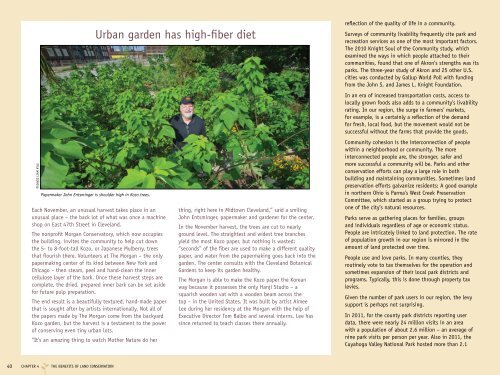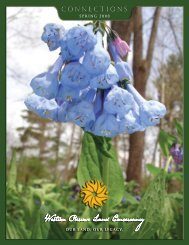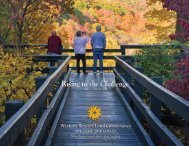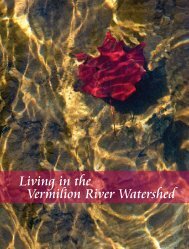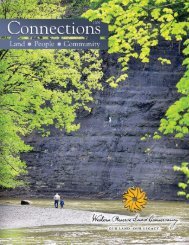Common Ground - Western Reserve Land Conservancy
Common Ground - Western Reserve Land Conservancy
Common Ground - Western Reserve Land Conservancy
Create successful ePaper yourself
Turn your PDF publications into a flip-book with our unique Google optimized e-Paper software.
© DAVID LIAM KYLE<br />
Each November, an unusual harvest takes place in an<br />
unusual place – the back lot of what was once a machine<br />
shop on East 47th Street in Cleveland.<br />
The nonprofit Morgan Conservatory, which now occupies<br />
the building, invites the community to help cut down<br />
the 5- to 8-foot-tall Kozo, or Japanese Mulberry, trees<br />
that flourish there. Volunteers at The Morgan – the only<br />
papermaking center of its kind between New York and<br />
Chicago – then steam, peel and hand-clean the inner<br />
cellulose layer of the bark. Once these harvest steps are<br />
complete, the dried, prepared inner bark can be set aside<br />
for future pulp preparation.<br />
The end result is a beautifully textured, hand-made paper<br />
that is sought after by artists internationally. Not all of<br />
the papers made by The Morgan come from the backyard<br />
Kozo garden, but the harvest is a testament to the power<br />
of conserving even tiny urban lots.<br />
“It’s an amazing thing to watch Mother Nature do her<br />
40 CHAPTER 4 THE BENEFITS OF LAND CONSERVATION<br />
Urban garden has high-fiber diet<br />
Papermaker John Entsminger is shoulder high in Kozo trees.<br />
thing, right here in Midtown Cleveland,” said a smiling<br />
John Entsminger, papermaker and gardener for the center.<br />
In the November harvest, the trees are cut to nearly<br />
ground level. The straightest and widest tree branches<br />
yield the most Kozo paper, but nothing is wasted:<br />
“seconds” of the fiber are used to make a different quality<br />
paper, and water from the papermaking goes back into the<br />
garden. The center consults with the Cleveland Botanical<br />
Gardens to keep its garden healthy.<br />
The Morgan is able to make the Kozo paper the Korean<br />
way because it possesses the only Hanji Studio – a<br />
squarish wooden vat with a wooden beam across the<br />
top – in the United States. It was built by artist Aimee<br />
Lee during her residency at the Morgan with the help of<br />
Executive Director Tom Balbo and several interns. Lee has<br />
since returned to teach classes there annually.<br />
reflection of the quality of life in a community.<br />
Surveys of community livability frequently cite park and<br />
recreation services as one of the most important factors.<br />
The 2010 Knight Soul of the Community study, which<br />
examined the ways in which people attached to their<br />
communities, found that one of Akron’s strengths was its<br />
parks. The three-year study of Akron and 25 other U.S.<br />
cities was conducted by Gallup World Poll with funding<br />
from the John S. and James L. Knight Foundation.<br />
In an era of increased transportation costs, access to<br />
locally grown foods also adds to a community’s livability<br />
rating. In our region, the surge in farmers’ markets,<br />
for example, is a certainly a reflection of the demand<br />
for fresh, local food, but the movement would not be<br />
successful without the farms that provide the goods.<br />
Community cohesion is the interconnection of people<br />
within a neighborhood or community. The more<br />
interconnected people are, the stronger, safer and<br />
more successful a community will be. Parks and other<br />
conservation efforts can play a large role in both<br />
building and maintaining communities. Sometimes land<br />
preservation efforts galvanize residents: A good example<br />
in northern Ohio is Parma’s West Creek Preservation<br />
Committee, which started as a group trying to protect<br />
one of the city’s natural resources.<br />
Parks serve as gathering places for families, groups<br />
and individuals regardless of age or economic status.<br />
People are intricately linked to land protection. The rate<br />
of population growth in our region is mirrored in the<br />
amount of land protected over time.<br />
People use and love parks. In many counties, they<br />
routinely vote to tax themselves for the operation and<br />
sometimes expansion of their local park districts and<br />
programs. Typically, this is done through property tax<br />
levies.<br />
Given the number of park users in our region, the levy<br />
support is perhaps not surprising.<br />
In 2011, for the county park districts reporting user<br />
data, there were nearly 24 million visits in an area<br />
with a population of about 2.6 million – an average of<br />
nine park visits per person per year. Also in 2011, the<br />
Cuyahoga Valley National Park hosted more than 2.1


